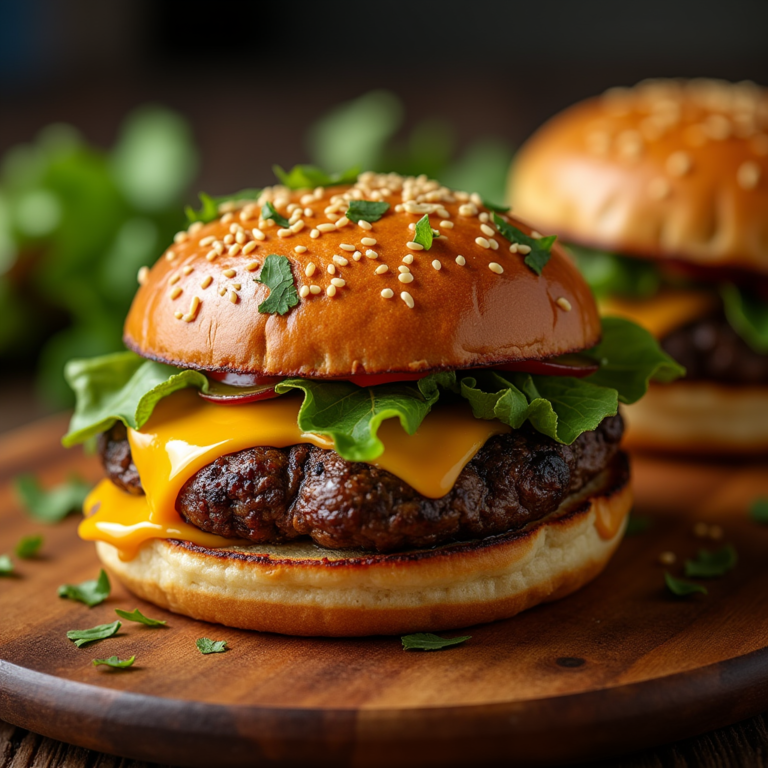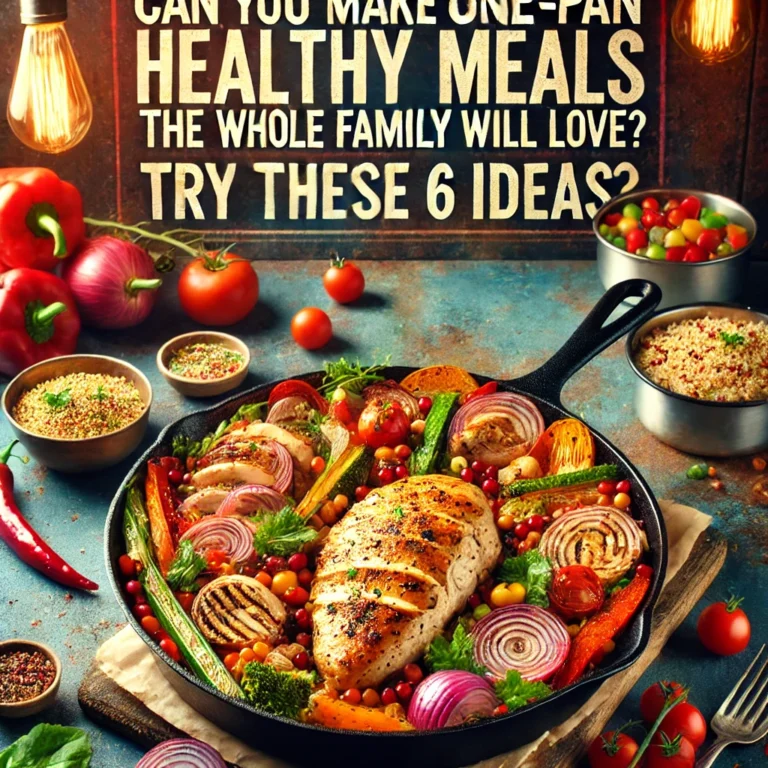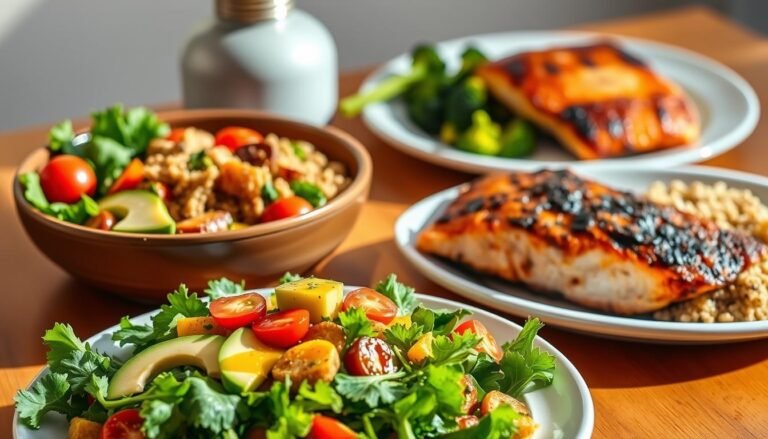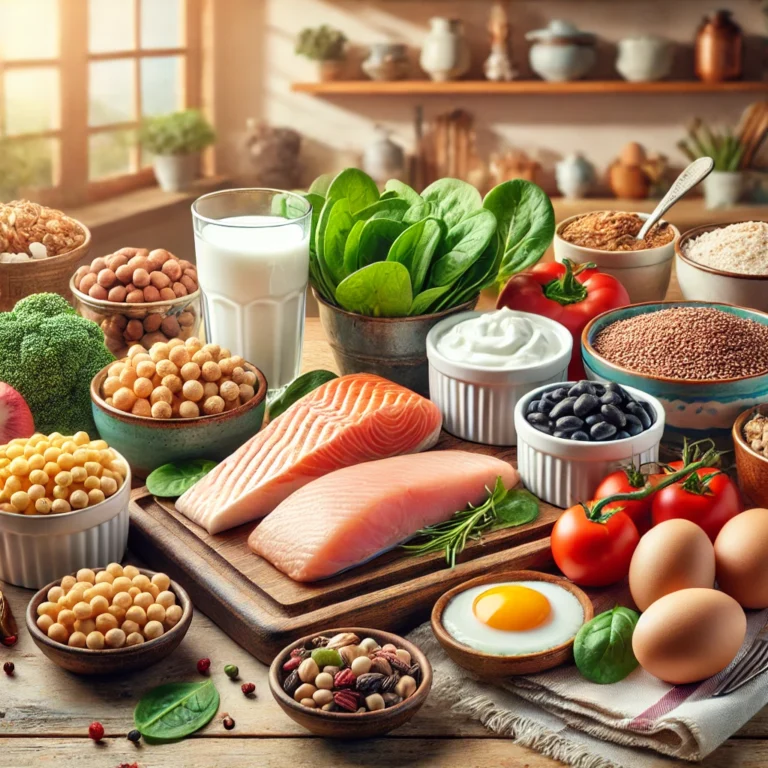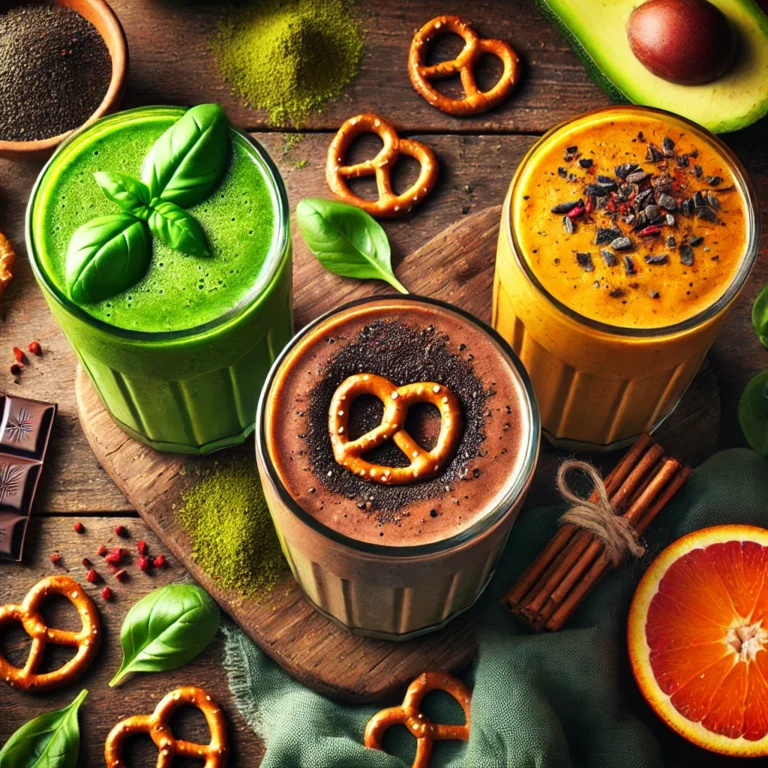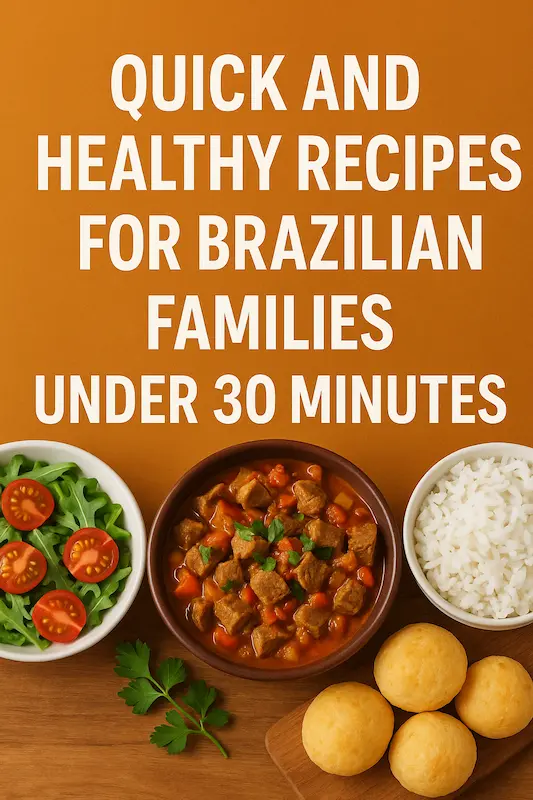Which Food Is Best For Fat Loss? 10 Simple Ways To Start
Table of Contents
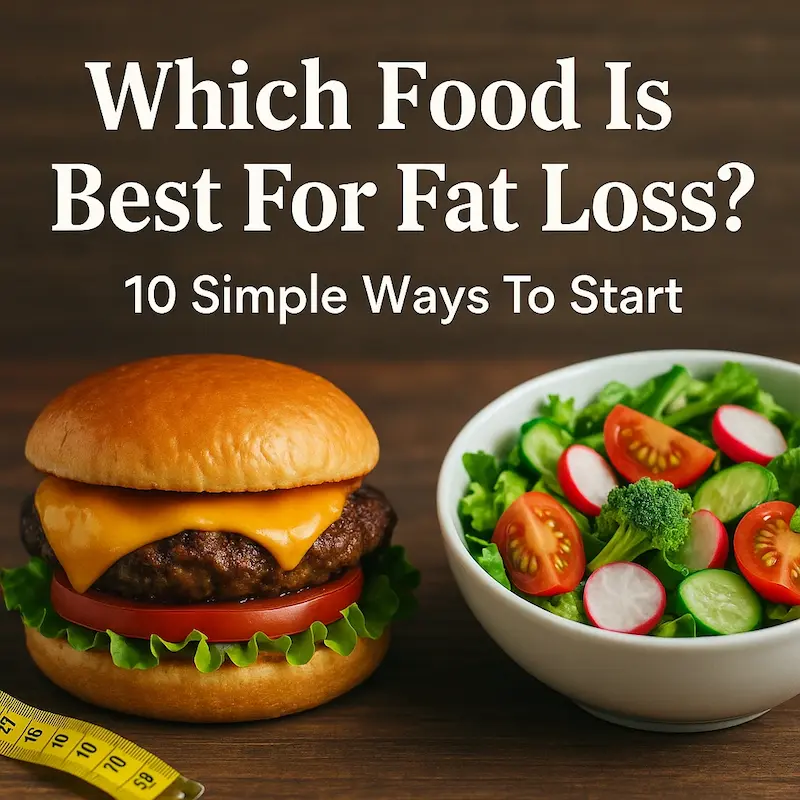
Did you know that 67% of Americans are actively trying to lose weight, yet only 15% consider their food choices as the primary factor in their weight loss journey? When it comes to shedding those stubborn pounds, the age-old question remains: which food is best for fat loss? While exercise plays a crucial role, nutrition experts agree that what you eat accounts for approximately 70-80% of your weight loss results. In this comprehensive guide, we’ll explore the most effective fat-burning foods and provide 10 simple ways to incorporate them into your daily routine, helping you kickstart your fat loss journey with confidence and clarity.
The Fat-Fighting Food List
Before diving into specific meal plans and recipes, let’s explore the powerhouse ingredients that should become staples in your fat loss journey. These foods have been scientifically proven to support weight management through various mechanisms – from boosting metabolism to controlling hunger hormones.
Lean Proteins
- Chicken breast (skinless): 31g protein per 100g, only 165 calories
- Turkey breast: Rich in B vitamins that support metabolism
- White fish (cod, halibut, tilapia): High protein, extremely low in fat
- Eggs: contain choline, which helps mobilize fat
- Greek yogurt: High protein content helps preserve muscle mass during weight loss
- Tofu: Plant-based complete proteins with fiber
Substitution options: For vegetarians, lentils, chickpeas, and quinoa can replace animal proteins while still providing essential amino acids.
Fibrous Vegetables
- Broccoli: It contains sulforaphane, which may help reduce fat storage
- Spinach: Rich in thylakoids that reduce cravings and hunger
- Kale: High nutrient density with minimal calories
- Bell peppers: Sweet flavor with high vitamin C content that assists fat oxidation
- Cauliflower: Versatile low-carb substitute for rice and potatoes
- Brussels sprouts: High fiber content promotes fullness
Substitution options: Any non-starchy vegetable works well; choose what’s seasonal and appealing to your palate.
Metabolism-Boosting Foods
- Chili peppers: Contain capsaicin that increases calorie burning
- Green tea: EGCG compounds support fat oxidation
- Coffee: Caffeine temporarily increases metabolic rate
- Apple cider vinegar: May help reduce insulin levels and increase satiety
- Cinnamon: Helps regulate blood sugar and reduce cravings
- Ginger: Thermogenic properties slightly increase calorie expenditure
Substitution options: If you’re sensitive to caffeine, try herbal alternatives like rooibos tea or dandelion root tea.
Healthy Fats
- Avocados: Monounsaturated fats signal fullness to the brain
- Olive oil: It contains oleic acid, which reduces inflammation
- Nuts (particularly almonds and walnuts): A Protein and fiber combination reduces hunger
- Seeds (chia, flax, hemp): Omega-3 fatty acids support hormone balance
- Fatty fish (salmon, mackerel, sardines): Omega-3s reduce inflammation and may decrease fat storage
Substitution options: If you have nut allergies, seeds offer similar benefits; plant-based omega-3 supplements can replace fatty fish.
Complex Carbohydrates
- Sweet potatoes: Low glycemic impact with high fiber
- Quinoa: Complete protein with complex carbs
- Oats: Beta-glucans help control appetite
- Beans and lentils: Resistant starch feeds beneficial gut bacteria
- Berries: Low-sugar fruits with high antioxidant content
- Apples: Pectin fiber helps regulate blood sugar
Substitution options: Any whole grain can replace another; fruits can be interchanged based on seasonality and preference.
Timing: When to Eat for Maximum Fat Loss
Understanding not just what to eat but when to eat can dramatically impact your fat loss results. Strategic timing optimizes hormonal responses and energy utilization.
Preparation time: 15-20 minutes for most fat-burning meals (60% less time than the average American spends preparing dinner)
Cooking time: Typically 15-30 minutes for most fat-loss friendly recipes
Total daily food prep time: 45-60 minutes (which can be reduced to 2-3 hours weekly with batch cooking)
Optimal meal frequency: Research suggests eating every 3-4 hours helps maintain stable blood sugar and prevents overeating, resulting in approximately 4-5 small meals daily rather than 3 large ones.
Strategic nutrient timing:
- Morning (6-9 AM): Higher protein and healthy fat intake
- Mid-day (11 AM-2 PM): Balanced meal with complex carbs, proteins, and vegetables
- Afternoon (3-4 PM): Small protein-rich snack with fiber
- Evening (6-8 PM): Protein and vegetables, lower in carbohydrates
- Pre-sleep (if needed): Small protein serving (casein or Greek yogurt) 30 minutes before bed
Step-by-Step Instructions for Fat Loss Success
Step 1: Clear Your Kitchen of Fat-Storing Foods
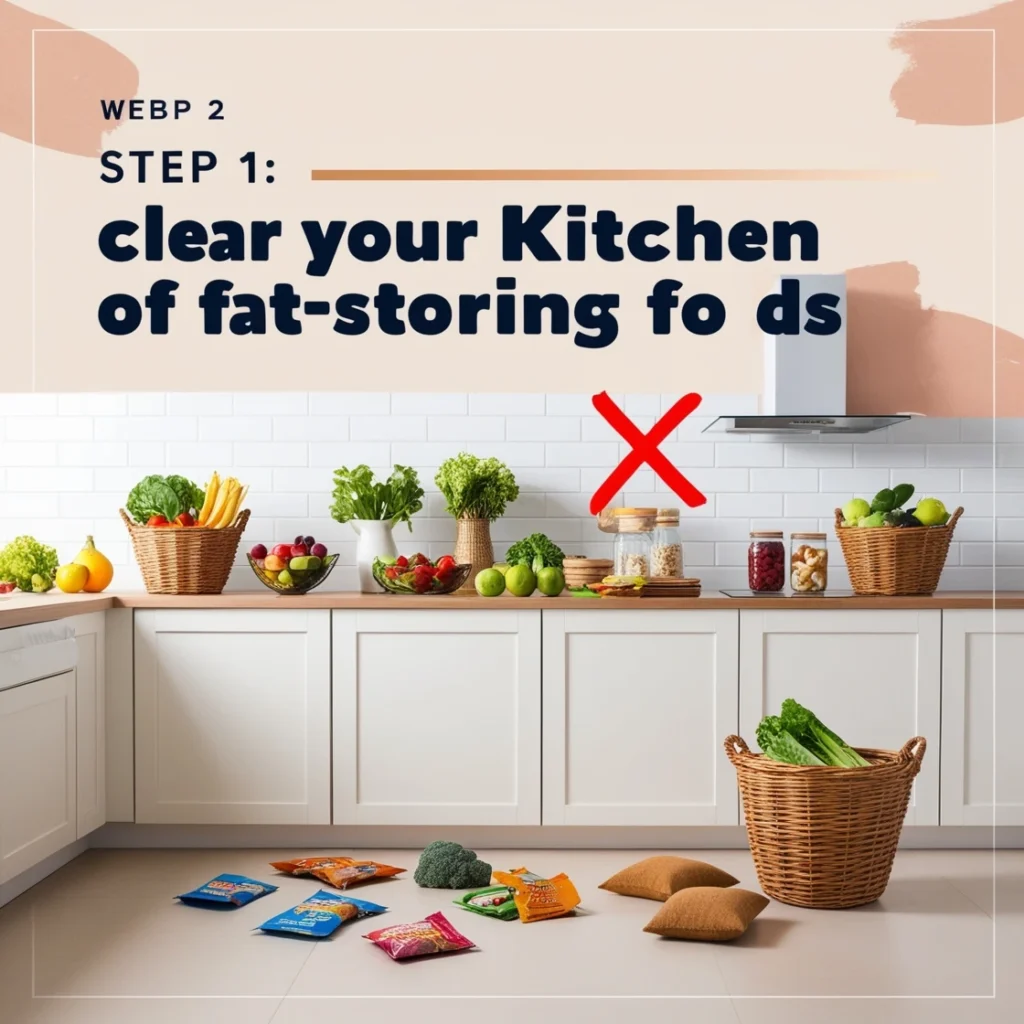
Start your fat loss journey by removing foods that trigger cravings and fat storage. According to research, having trigger foods visible increases consumption by up to 300%.
- Remove refined sugars, white flours, and processed snacks
- Clear out high-sodium packaged foods that cause water retention
- Eliminate sugar-sweetened beverages (a single daily soda can add 15 pounds yearly)
- Check condiments for hidden sugars and unhealthy oils
- Replace processed cooking oils with olive oil, avocado oil, or coconut oil
Pro tip: Don’t just throw everything away—gradually replace items as they run out with healthier alternatives to minimize waste and make the transition more sustainable.
Step 2: Stock Up on Fat-Burning Foods

Transform your kitchen into a fat-loss-friendly environment by strategically shopping for and storing the right foods.
- Dedicate 60% of your shopping cart to fresh produce
- Choose proteins from the lean protein list above
- Select complex carbohydrates that score low on the glycemic index
- Purchase healthy fats in appropriate portion sizes
- Buy herbs and spices that enhance flavor without adding calories
Pro tip: Shop the perimeter of the grocery store first, where fresh foods are typically located, before venturing into the center aisles where processed foods dominate.
Step 3: Master Portion Control Without Measuring
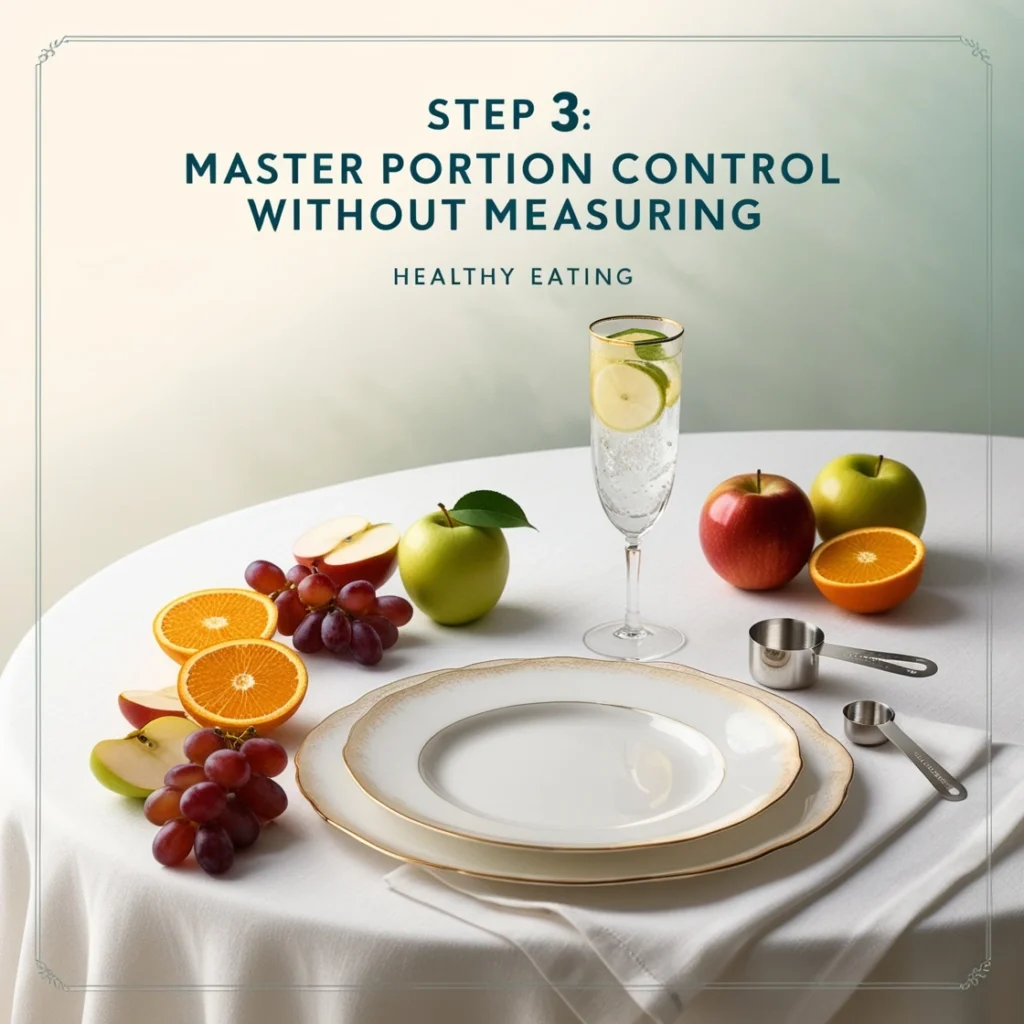
While calorie counting works for some, it’s not sustainable for most people. Instead, use these visual cues:
- Protein portions: Size of your palm (about 20-30g protein)
- Complex carbohydrates: Cupped hand (approximately 20-30g carbs)
- Healthy fats: Thumb size (about 7-12g fat)
- Vegetables: As much as you can fit on your open hand
- Fruits: Size of your fist (contains about 15-20g carbs)
Pro tip: Using smaller plates can reduce calorie consumption by 22% according to Cornell University research, without leaving you feeling deprived.
Step 4: Implement Strategic Meal Prepping
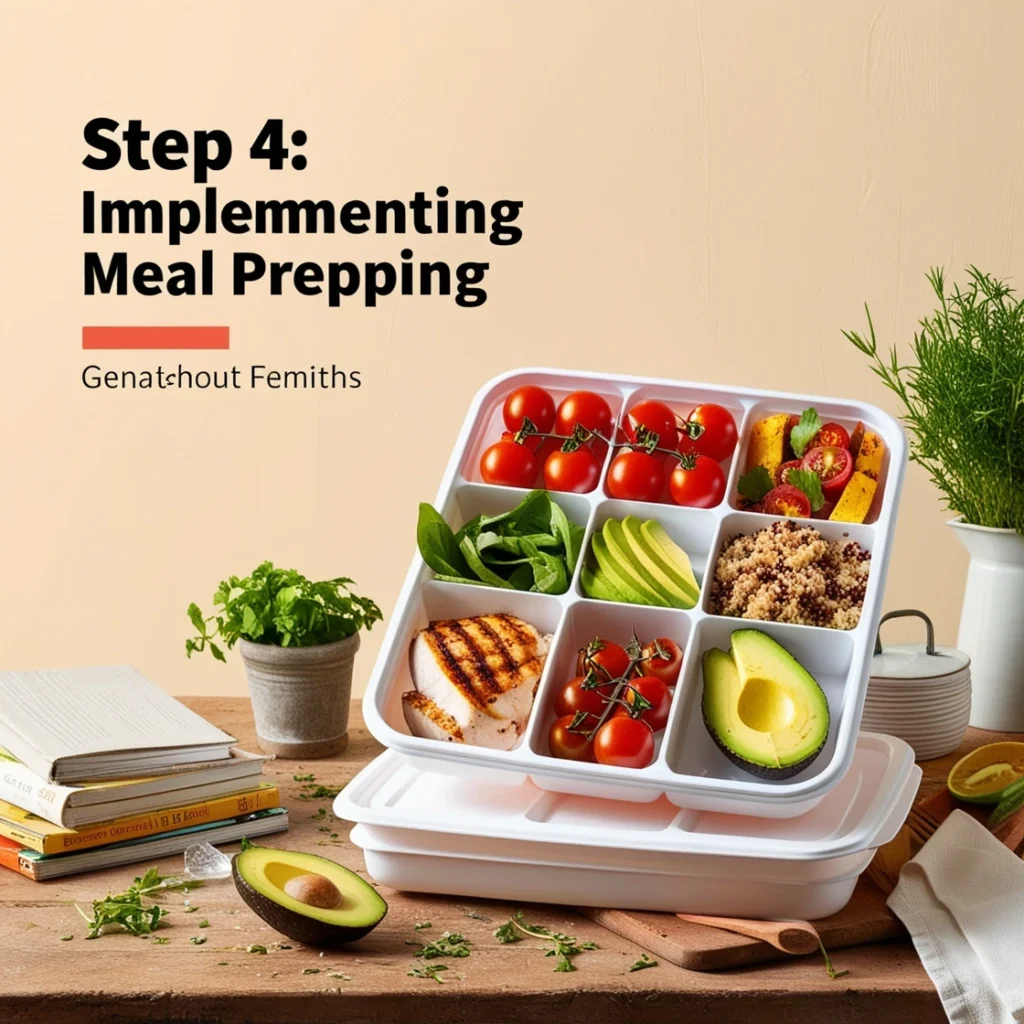
Preparation is crucial for consistent fat loss results. Studies show that people who meal prep eat a wider variety of foods and consume fewer calories overall.
- Dedicate 2-3 hours weekly to batch cooking proteins and complex carbs
- Wash and chop vegetables in advance for quick assembly
- Prepare portable snacks in single-serving containers
- Create “emergency” fat-loss-friendly meals for busy days
- Use the cook-once-eat-twice approach for efficiency
Pro tip: Invest in quality food storage containers that are compartmentalized to help control portions and keep foods fresh longer.
Step 5: Hydrate Strategically for Fat Loss
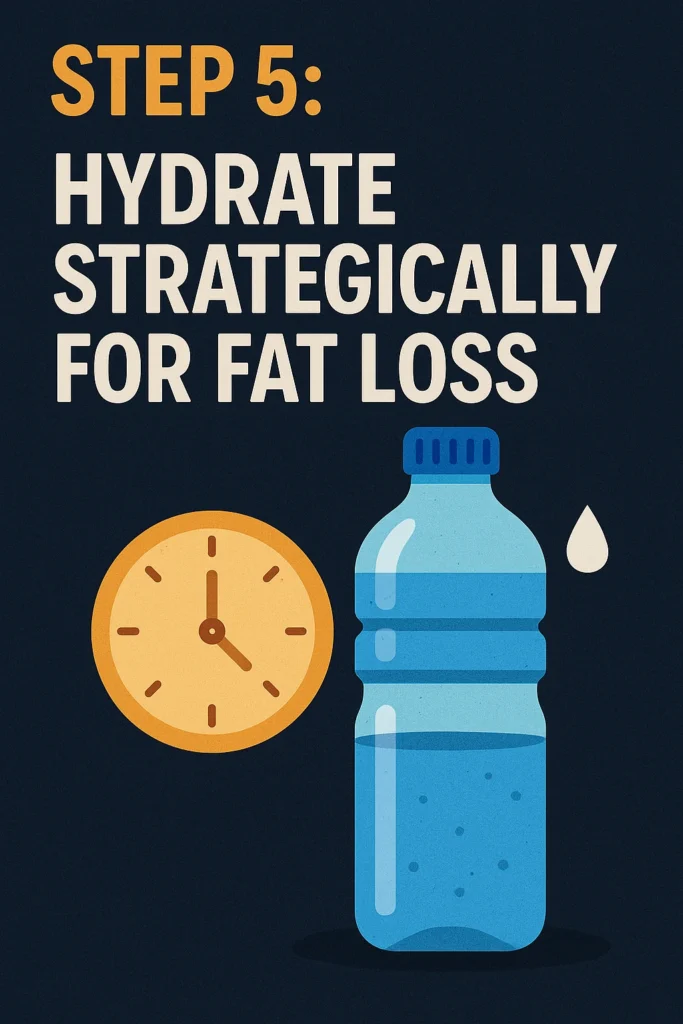
Water intake directly impacts your body’s ability to metabolize fat, with research showing that proper hydration can increase metabolism by up to 30%.
- Drink 16oz of water immediately upon waking to rehydrate and boost metabolism.
- Consume 8oz of water 30 minutes before each meal to enhance satiety
- Drink water between meals rather than with meals to optimize digestion
- Add metabolism-boosting enhancers like lemon, cucumber, or ginger
- Track intake with a marked water bottle (aim for 0.5-1oz per pound of body weight)
Pro tip: Set phone reminders to drink water every hour, or use apps specifically designed to track and remind you about hydration throughout the day.
Step 6: Incorporate Protein at Every Meal
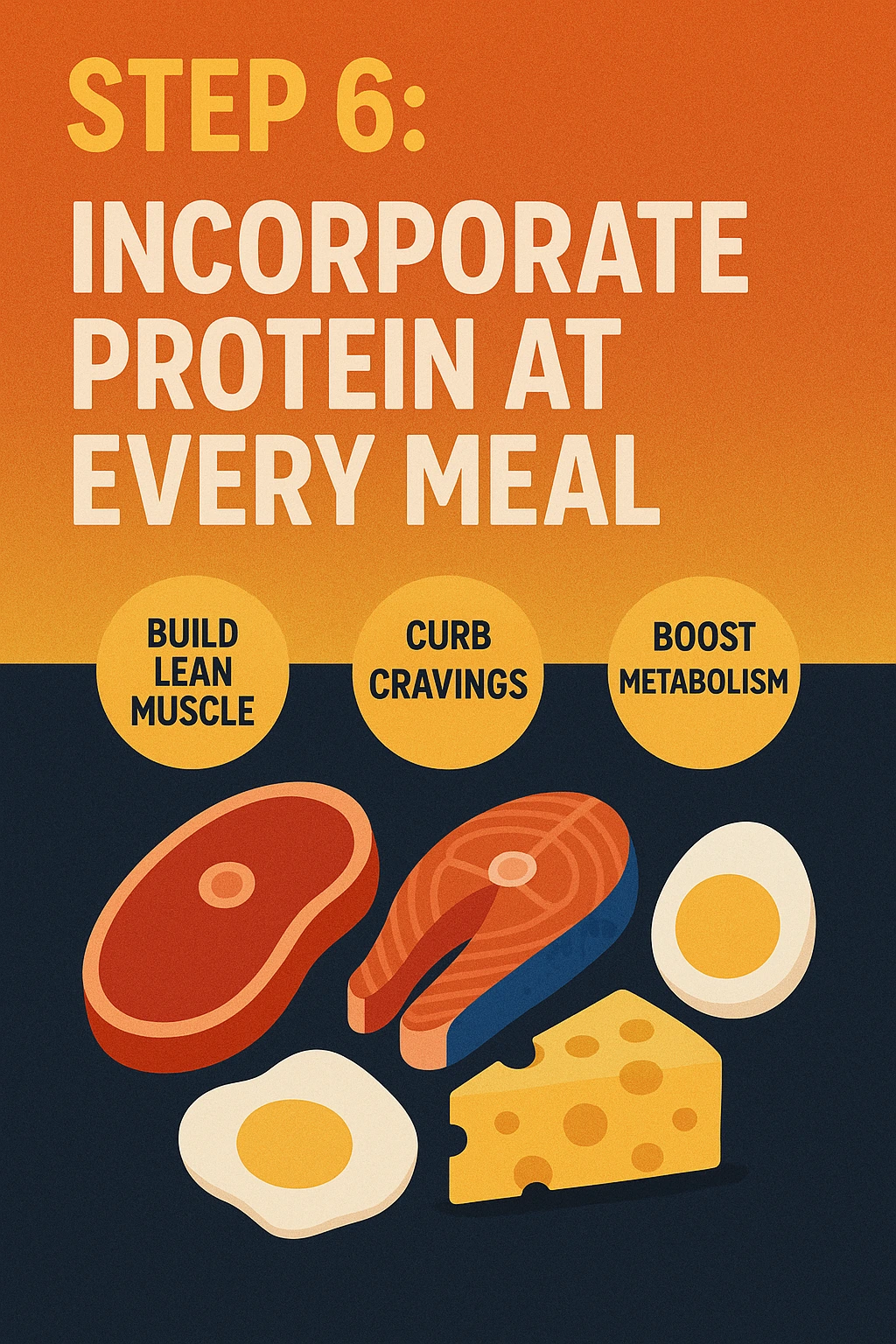
Protein is the most thermogenic macronutrient, requiring 20-30% of its calories just for digestion and absorption (compared to 5-10% for carbs and 0-3% for fats).
- Start your day with 20-30g of protein at breakfast
- Include a palm-sized protein source at lunch and dinner
- Add small protein portions to snacks (5-10g)
- Consider plant and animal proteins for nutritional variety
- Space protein intake evenly throughout the day (rather than loading up at dinner)
Pro tip: Keep ready-to-eat protein sources available, such as hard-boiled eggs, Greek yogurt, or protein powder, for busy days when cooking isn’t possible.
Step 7: Time Your Carbohydrates Wisely
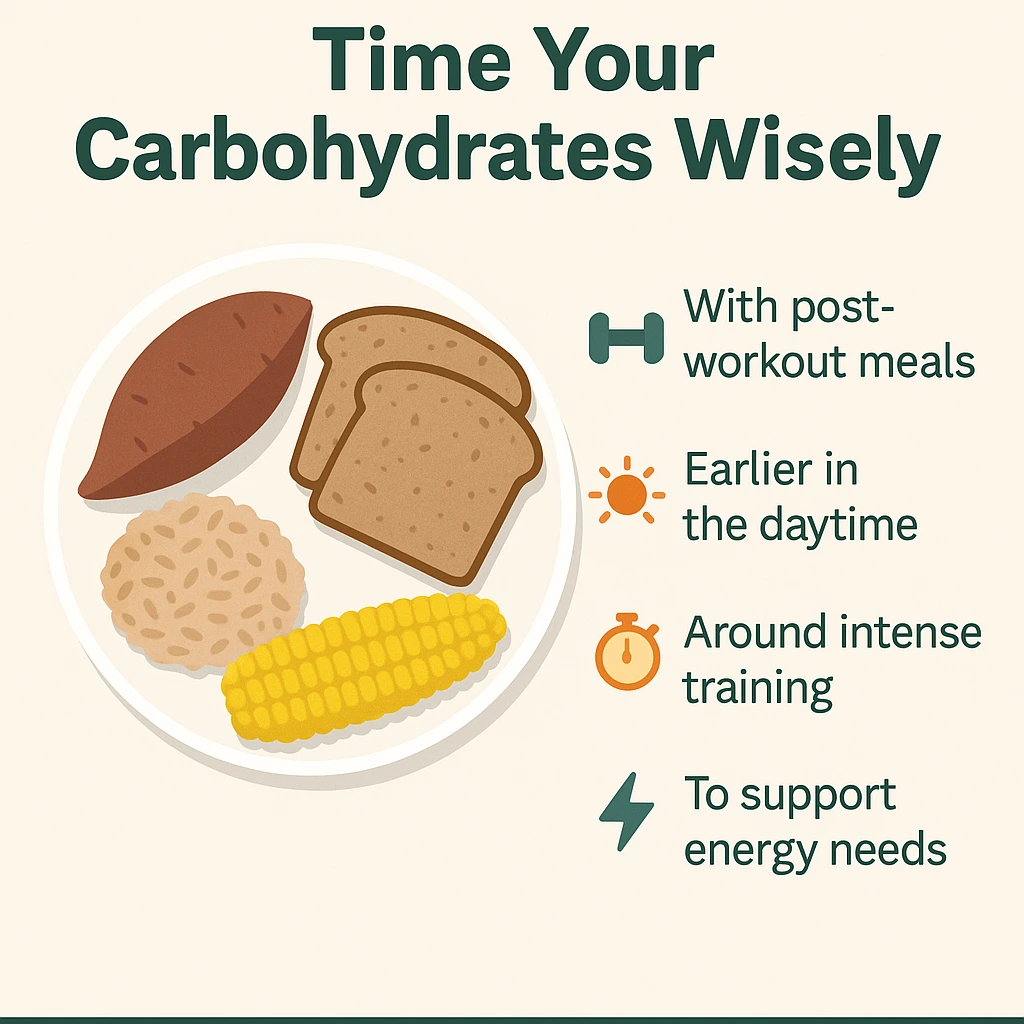
Not all carbohydrates are created equal, and when you consume them matters almost as much as which ones you choose.
- Consume most complex carbohydrates in the morning and around workouts
- Reduce carbohydrate portions in evening meals
- Pair carbohydrates with proteins to slow digestion and reduce insulin spikes.
- Choose high-fiber options that contain at least 3g of fiber per serving
- Schedule higher carbohydrate meals on more active days
Pro tip: Track your energy levels after different carbohydrate timing strategies to discover your body’s optimal pattern, as individual responses vary significantly.
Step 8: Leverage the Power of Thermogenic Foods
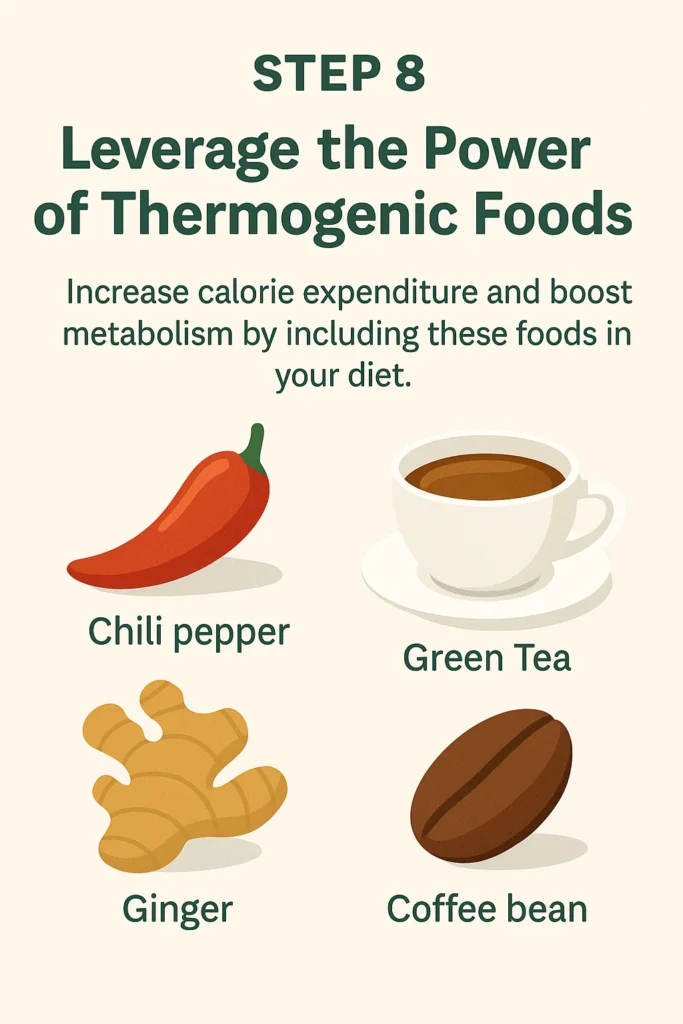
Certain foods naturally increase your metabolic rate through a process called diet-induced thermogenesis.
- Add 1 tablespoon of apple cider vinegar to water before meals
- Include cayenne or hot peppers in at least one meal daily
- Consume 2-3 cups of green tea throughout the day
- Use cinnamon to flavor foods instead of sugar
- Incorporate ginger into meals or beverages regularly
Pro tip: Create a morning metabolism-boosting elixir with warm water, lemon juice, cayenne pepper, ginger, and a touch of maple syrup to kick-start your metabolism.
Step 9: Implement Strategic Fasting Windows
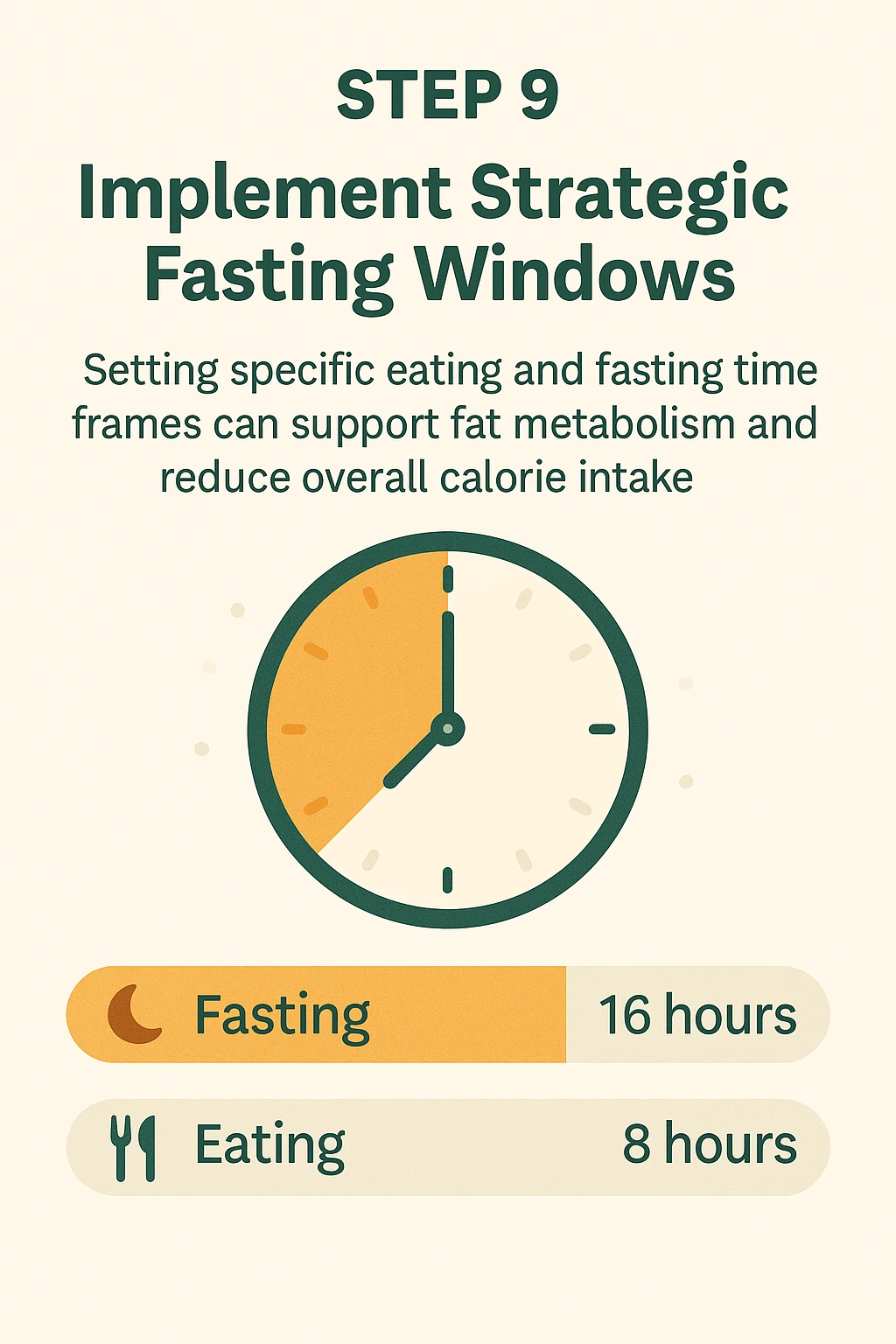
When implemented correctly, intermittent fasting can enhance fat-burning hormones. Research shows it may increase norepinephrine levels, directly signaling fat cells to release stored energy.
- Start with a 12-hour overnight fast (8 PM to 8 AM)
- Gradually extend to 14-16 hours if comfortable
- Break your fast with protein and healthy fats, not carbohydrates
- Maintain proper hydration during fasting periods
- Adjust fasting windows to align with your natural hunger patterns
Pro tip: Use herbal teas and black coffee during fasting windows to reduce hunger while providing beneficial antioxidants that support metabolism.
Step 10: Track and Adjust Based on Results
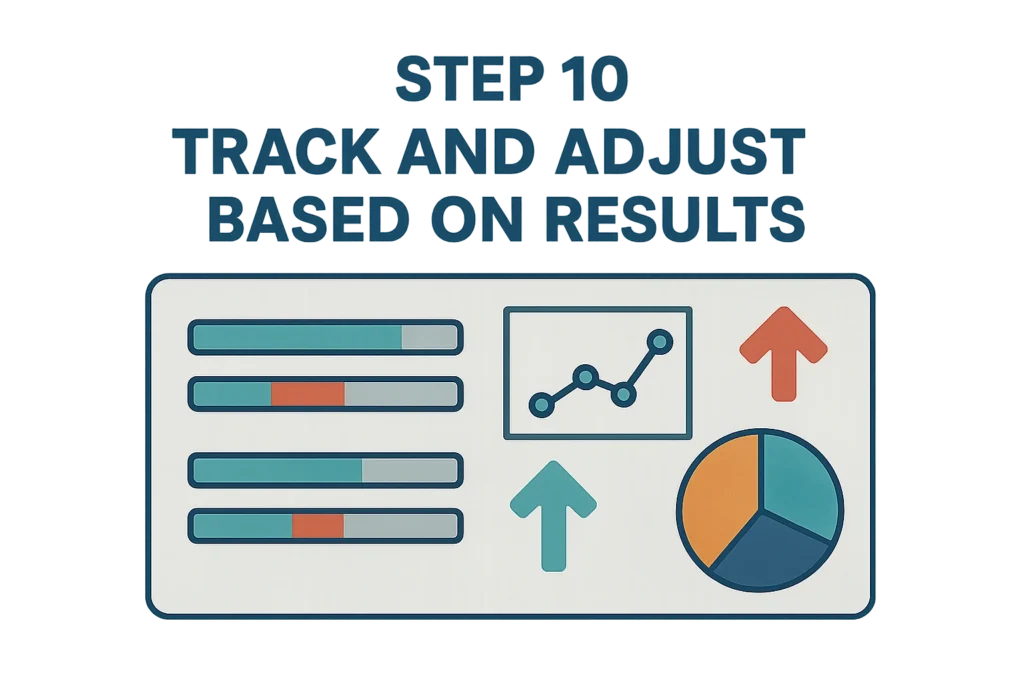
Consistent monitoring allows for personalized adjustments that optimize your individual fat loss journey.
- Take weekly measurements (weight, inches, photos) rather than daily
- Keep a food journal for at least the first 30 days
- Note energy levels, mood, and hunger alongside food choices
- Look for patterns between food choices and progress
- Make one small adjustment weekly rather than overhauling everything at once
Pro tip: Focus on non-scale victories like improved energy, better sleep, and clothing fit rather than obsessing over the number on the scale, which can fluctuate due to factors unrelated to fat loss.
Nutritional Information
Understanding the nutritional profile of fat-burning foods helps you make informed choices that align with your goals. Here’s a breakdown of key nutrients in a typical fat-loss optimized day:
Macronutrient Distribution:
- Protein: 30-35% of total calories (approximately 1.6-2.2g per kg of body weight)
- Carbohydrates: 30-40% of total calories (primarily from fibrous vegetables and limited complex sources)
- Fats: 25-35% of total calories (emphasizing omega-3s and monounsaturated sources)
Micronutrient Focus:
- Vitamin D: Supports hormone production and fat metabolism
- B vitamins: Essential for energy production and metabolism
- Magnesium: Required for over 300 biochemical reactions, including glucose control
- Zinc: Supports thyroid function, which regulates metabolism
- Chromium: Helps regulate blood sugar and reduce cravings
Fiber Content:
- Aim for 25-35g daily (most Americans consume only 15g)
- Soluble fiber: 10-15g (forms gel in digestive tract, slowing digestion)
- Insoluble fiber: 15-20g (adds bulk and speeds transit time)
Hydration:
- Water: Minimum 2-3 liters daily (about 8-12 cups)
- Herbal teas: Unlimited, particularly green tea (3-4 cups recommended)
- Coffee: Limit to 2-3 cups daily, preferably before 2 PM
Caloric Range:
- Women: Typically 1,200-1,600 calories for fat loss (varies by activity level)
- Men: Typically 1,600-2,000 calories for fat loss (varies by activity level)
- Note: Never go below 1,200 calories for women or 1,500 for men to maintain proper metabolic function
Healthier Alternatives for Common Fat-Storing Foods
Making strategic swaps can dramatically reduce calories while maintaining satisfaction. Here are science-backed substitutions that can transform your fat loss results:
Instead of Refined Carbohydrates:
- Swap white rice (204 calories/cup) for cauliflower rice (25 calories/cup)
- Replace wheat pasta (221 calories/cup) with spiralized zucchini (35 calories/cup)
- Use lettuce wraps instead of tortillas (saving approximately 120 calories per wrap)
- Choose sweet potatoes over white potatoes (more fiber, vitamins, and lower glycemic impact)
Instead of Sugar-Laden Treats:
- Replace ice cream with frozen Greek yogurt with berries (saving 150+ calories per serving)
- Swap milk chocolate for 70 %+ dark chocolate (reducing sugar by up to 40%)
- Use pureed frozen bananas instead of milkshakes (saving 300+ calories)
- Choose fresh fruit with cinnamon instead of fruit juices or smoothie bowls
Instead of High-Calorie Condiments:
- Replace mayonnaise (94 calories/tbsp) with Greek yogurt (5 calories/tbsp)
- Swap store-bought salad dressings for olive oil and vinegar or lemon juice
- Use avocado as a spread instead of butter (similar calories but healthier fats)
- Choose salsa over ketchup (fewer sugars and more nutrients)
Instead of Processed Snacks:
- Swap chips (160 calories/oz) for air-popped popcorn (110 calories/oz)
- Replace crackers with cucumber or zucchini slices topped with hummus
- Choose Greek yogurt with berries instead of flavored yogurt cups (saving 15g sugar)
- Opt for roasted chickpeas instead of trail mix (more protein, less fat)
Instead of Sugary Beverages:
- Replace soda with sparkling water infused with fruit (saving 140 calories per 12oz)
- Swap sweetened coffee drinks for black coffee with cinnamon and a splash of almond milk
- Choose herbal teas instead of fruit juices (saving 120+ calories per cup)
- Use protein smoothies instead of meal replacement shakes (better nutrient profile)
Serving Suggestions for Fat-Burning Meals
Transform ordinary fat-burning foods into exciting, satisfying meals with these creative serving ideas that maintain the nutritional profile while enhancing enjoyment.
Breakfast Options:
- Greek yogurt parfait with berries, chia seeds, and a sprinkle of cinnamon
- Vegetable omelet with avocado and a side of mixed berries
- Overnight oats with protein powder, almond butter, and cinnamon
- Smoked salmon with cucumber slices and herbed cream cheese
- Protein pancakes topped with Greek yogurt and fresh berries
Lunch Combinations:
- Mason jar salads with protein, vegetables, and dressing on the bottom
- Lettuce wraps filled with lean protein, avocado, and crunchy vegetables
- Cauliflower rice bowls with grilled chicken and roasted vegetables
- Cold lentil salad with diced vegetables and light vinaigrette
- Protein-packed bento boxes with compartmentalized portions
Dinner Presentations:
- Zucchini noodles with turkey meatballs and fresh marinara sauce
- Grilled fish with a colorful roasted vegetable medley
- Stuffed bell peppers with ground turkey and quinoa
- Cauliflower crust pizza topped with lean protein and vegetables
- Spaghetti squash boats filled with shredded chicken and vegetables
Smart Snack Arrangements:
- Cucumber rounds topped with tuna salad made with Greek yogurt
- Bell pepper strips with guacamole, individual portions
- Turkey roll-ups with hummus and thin vegetable strips
- Hard-boiled eggs with everything bagel seasoning
- Greek yogurt bark with berries and crushed nuts
Hydration Enhancements:
- Infused water pitchers with cucumber, mint, and berries
- Iced green tea with lemon slices and fresh mint
- Warm ginger tea with lemon and a touch of honey
- Sparkling water with muddled berries and basil leaves
- Pre-workout hydration with electrolytes and a pinch of sea salt
Common Mistakes to Avoid in Your Fat Loss Journey
Even with the best intentions, many people sabotage their fat loss efforts through common mistakes. Here’s how to identify and avoid these pitfalls:
Mistake #1: Focusing Only on “Diet” Foods Research shows that 65% of “diet” or “low-fat” packaged foods contain nearly the same calories as their regular counterparts but often include more sugar and artificial ingredients. Solution: Choose whole, single-ingredient foods instead of packaged “diet” products.
Mistake #2: Eliminating All Carbohydrates Studies indicate that extremely low-carb diets lead to reduced exercise performance in 78% of participants, making workouts less effective for fat burning. Solution: Incorporate strategic amounts of complex carbohydrates, particularly around workout times.
Mistake #3: Not Eating Enough Protein Data shows that inadequate protein intake (below 0.8g per kg of body weight) results in muscle loss alongside fat loss, slowing metabolism over time. Solution: Prioritize protein at every meal, aiming for 25-30g per main meal.
Mistake #4: Over-Relying on Exercise Without Nutrition Changes. Research from the International Journal of Obesity reveals that exercise alone, without dietary modification, produces only 2-3% weight loss over 6-12 months. Solution: Focus on the 80/20 rule—80% nutrition, 20% exercise for optimal results.
Mistake #5: Consuming Hidden Calories in Beverages The average American consumes 22% of their daily calories through liquids, often without registering these as food intake. Solution: Stick to water, black coffee, and herbal teas; avoid caloric beverages, including most smoothies.
Mistake #6: Weekend Overindulgence Studies show that many people consume up to 40% more calories on weekends, potentially negating the deficit created during the week. Solution: Maintain consistent eating patterns seven days a week, allowing planned, portion-controlled treats rather than full “cheat days.”
Mistake #7: Misunderstanding Portion Sizes Research indicates that most people underestimate their food portions by 20-40%, particularly with calorie-dense foods like nuts, oils, and nut butters. Solution: Use the hand measurement system described earlier or measure portions for two weeks to reset your visual perception.
Mistake #8: Eating Too Quickly. It takes approximately 20 minutes for satiety hormones to register fullness, but the average American meal is consumed in just 13 minutes. Solution: Set a timer for 20 minutes per meal and focus on chewing thoroughly.
Mistake #9: Not Planning for Social Situations. Unplanned restaurant visits or social gatherings can increase calorie consumption by 35% according to research from the Journal of Nutrition. Solution: Research menus in advance, eat a small protein-rich snack before events, and decide on your choices before arriving.
Mistake #10: All-or-Nothing Mentality. Data shows that those who view minor setbacks as total failures are 60% more likely to abandon their fat loss efforts entirely. Solution: Embrace the 80/20 approach—aim for excellence, not perfection, knowing that consistency trumps occasional deviations.
Storing Tips for Fat-Burning Foods
Proper storage not only preserves nutrients but also ensures you always have fat-burning foods ready when hunger strikes, preventing impulsive choices.
Protein Storage:
- Store raw proteins on the bottom shelf of the refrigerator for food safety
- Cooked proteins remain safe for 3-4 days when properly refrigerated
- Freeze individual portions of cooked proteins for up to 3 months
- Label and date all stored proteins to ensure freshness
- Thaw frozen proteins in the refrigerator rather than at room temperature
Vegetable Preservation:
- Store most vegetables unwashed until ready to use (except greens for salads)
- Use breathable produce bags rather than plastic for a longer shelf life
- Keep cut vegetables in water-filled containers for crispness (carrots, celery)
- Blanch vegetables before freezing to preserve nutrients and texture
- Utilize the crisper drawer with humidity controls adjusted appropriately
Healthy Fat Preservation:
- Store oils in dark glass bottles away from heat sources
- Keep nuts and seeds in the refrigerator or freezer to prevent rancidity
- Use vacuum-sealed containers to extend the shelf life of fatty foods
- Purchase smaller quantities of oils and fatty foods to ensure freshness
- Date all opened packages of fats and use them within the recommended timeframes
Meal Prep Storage Strategies:
- Use glass containers rather than plastic when possible (especially for hot foods)
- Store dressings and sauces separately from pre-made salads
- Freeze individual portions in silicone muffin tins for perfect portion control
- Layer ingredients properly in mason jars (wet ingredients at the bottom, greens on top)
- Leave room for expansion when freezing liquids like soups and stews
Smart Refrigerator Organization:
- Keep fat-burning foods at eye level for easy access and visibility
- Store prepped vegetables and proteins in clear containers
- Create a designated “grab first” section for foods approaching expiration
- Maintain a weekly inventory to minimize waste and maximize usage
- Clean the refrigerator weekly to prevent cross-contamination and food waste
Conclusion
Which food is best for fat loss? The answer lies not in a single miracle ingredient but in a strategic approach combining lean proteins, fibrous vegetables, metabolism-boosting foods, healthy fats, and complex carbohydrates. By implementing the 10 simple steps outlined in this guide—from kitchen clearance to strategic meal timing—you can transform your body’s fat-burning potential through everyday food choices. Remember that sustainable fat loss comes from consistent habits rather than extreme measures, and the foods that best support your journey are those you can realistically incorporate into your lifestyle long-term.
FAQs
Q: How quickly will I see results when incorporating these fat-burning foods? A: Most people notice initial changes in energy and hunger levels within 7-10 days, with measurable fat loss typically beginning after 2-3 weeks of consistent implementation. Remember that sustainable fat loss occurs at a rate of 1-2 pounds weekly for most individuals.
Q: Do I need to eat all these fat-burning foods to see results? A: No, you don’t need to incorporate every food mentioned. Start by including 3-5 new fat-burning foods weekly, focusing on those you genuinely enjoy. Consistency with foods you like is more effective than forcing yourself to eat foods you dislike.
Q: Can I still eat carbohydrates and lose fat? A: Absolutely! The type, timing, and portion size of carbohydrates matter more than complete elimination. Focus on fiber-rich, complex carbohydrates earlier in the day and around workouts while reducing portions in evening meals.
Q: Is calorie counting necessary for fat loss? A: While creating a calorie deficit is essential for fat loss, counting calories isn’t mandatory. Many people achieve excellent results using the portion control methods and food quality guidelines outlined in this article without tracking specific numbers.
Q: How does protein help with fat loss specifically? A: Protein supports fat loss through several mechanisms: it requires more energy to digest (thermic effect), helps preserve muscle mass during weight loss, increases satiety hormones, stabilizes blood sugar, and provides essential amino acids for metabolic functions.
Q: Can vegetarians and vegans follow these fat loss recommendations? A: Absolutely! Plant-based eaters can achieve excellent fat loss results by focusing on plant proteins (legumes, tofu, tempeh), healthy fats (avocado, nuts, seeds), and abundant vegetables. Simply substitute plant-based alternatives where animal products are mentioned.
Q: Should I avoid fruit because of the sugar content? A: No, whole fruits contain fiber, water, vitamins, and minerals that slow sugar absorption and provide valuable nutrients. Focus on lower-sugar options like berries, apples, and citrus fruits, and consider timing fruit consumption earlier in the day or around workouts.
Q: How much water should I drink for optimal fat loss? A: A good guideline is 0.5-1 ounce of water per pound of body weight daily. For example, a 150-pound person would aim for 75-150 ounces (approximately 9-18 cups) of water daily, adjusted for activity level and climate.
Q: Can I include cheat meals while trying to lose fat? A: Rather than “cheat meals,” consider planned, portion-controlled indulgences that fit within your overall nutritional strategy. This mindset shift prevents the all-or-nothing thinking that often leads to overeating. Limit these to 1-2 meals weekly for optimal progress.
Q: How do hormones affect fat loss, and can food choices impact hormones? A: Hormones significantly influence fat storage and metabolism. Foods like fatty fish (omega-3s), cruciferous vegetables (support estrogen balance), and cinnamon (improves insulin sensitivity) can positively impact hormonal balance. Consistently elevated insulin from high-sugar diets is particularly problematic for fat storage.
Ready to transform your body with fat-burning foods? Start implementing these strategies today and share your experience in the comments below!
Source links
1. Best Diets 2025: Mediterranean Diet Still Tops the Rankings
WebMD
Discusses the Mediterranean diet’s effectiveness for weight loss, gut health, and chronic disease prevention.
URL: https://www.webmd.com/diet/news/20250106/best-diets-2025-mediterranean-still-tops-rankings
2. 11 Healthy Foods That Help You Burn Fat
Healthline
Lists protein-rich foods, omega-3 sources, and metabolism-boosting ingredients like green tea and chili peppers.
URL: https://www.healthline.com/nutrition/12-fat-burning-foods
3. 16 Healthy Foods to Support Weight Loss
Healthline
Highlights nutrient-dense foods like leafy greens, eggs, and legumes that promote satiety and fat oxidation.
URL: https://www.healthline.com/nutrition/most-weight-loss-friendly-foods 7
4. 12 Metabolism-Boosting Foods to Aid Weight Loss
UnityPoint Health
Recommends foods like fatty fish, legumes, and whole grains to enhance metabolic efficiency.
URL: https://www.unitypoint.org/news-and-articles/12-metabolism-boosting-foods-to-aid-weight-loss
5. The Best Diets of 2025, According to Registered Dietitians
Good Housekeeping
Focuses on sustainable diets like Mediterranean and Flexitarian, emphasizing whole foods and lifestyle changes.
URL: https://www.goodhousekeeping.com/health/diet-nutrition/a63249501/best-diets-of-2025
6. 25 Fat-Burning Foods to Help Boost Metabolism
Prevention
Includes spices (ginger, turmeric), lean proteins, and high-fiber options like beans and quinoa.
URL: https://www.prevention.com/weight-loss/g24805401/fat-burning-foods/
7. 26 Fat-Fighting Foods to Energize You
Santiam Hospital & Clinics
Covers practical foods like Greek yogurt, berries, and lean meats for sustainable weight management.
URL: https://santiamhospital.org/26-fat-fighting-foods-to-energize-you/
8. 2025 Best Diet Wins Gold for Wellness and Disease Prevention
CNN
Highlights the Mediterranean diet’s dominance in U.S. News rankings, with evidence-based benefits for fat loss.
URL: https://www.cnn.com/2025/01/03/health/2025-best-diet-wellness
9. 13 Fat-Burning Foods and Drinks To Add to Your Diet
Health
Explores thermogenic foods like green tea, whey protein, and MCT oil, supported by clinical studies.
URL: https://www.health.com/fat-burning-foods-8677545
10. 5 Best Weight Loss Programs in 2025
Healthline
Compares structured programs like Noom and WeightWatchers, emphasizing evidence-based strategies.
URL: https://www.healthline.com/nutrition/best-weight-loss-programs

